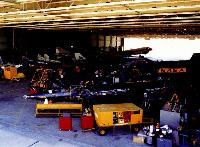
Варианты
- Douglas - F4D Skyray - 1951 - США
- Douglas - F5D Skylancer - 1956 - США
Douglas F4D и F-6 Skyray
<...>
Предлагалось развитие проекта под обозначением F4D-2N с улучшенными всепогодными возможностями. В итоге появился вариант F5D-1 Skylancer. В 1953 году были заказаны два прототипа с крыльями с сильно уменьшенным отношением толщины к длине хорды, удлиненным фюзеляжем, переделанным килем и новым фонарем кабины. Первый такой самолет впервые взлетел 21 апреля 1956 года.
К тому времени заказали девять предсерийных и 51 серийную машину, но после летных испытаний программу закрыли из-за того, что характеристики F5D оказались не намного лучше показателей самолета Vought F8U-1 Crusader, принимавшегося тогда на вооружение. Однако четыре построенных прототипа F5D-1 все же оказались полезными - они использовались ВМФ США в качестве летающих лабораторий для испытаний различного оборудования. Затем их передали агентству НАСА.
- Описание
Фотографии
-
Aeroplane Monthly 1977-05 / H.Andrews - Douglas F4D Skyray /Fighters of the fifties/ (14)
XF5D-1 (F4D-2) Skylancer prototype aircraft
-
Изд-во Schiffer / S.Markman & B.Holder - One-of-a-kind research aircraft
This particular F-5D, which was flown by Neil Armstrong, and is now on display in front of the Neil Armstrong Museum at Wapakoneta, Ohio, just north of Dayton.
-
Авиация и Космонавтика 2025-05 / В.Хвощин - Видеть дальше "буратиньего носа" (6)
Тот самый F5D-1 «Skylancer», но уже с регистрацией «NASA 802», установленный на постаменте перед Аэрокосмическим музеем Нейла Армстронга в его родном городе Уапаконета, шт. Огайо. В Центре летных исследований NASA этот самолет участвовал в различных испытаниях вплоть до 1970 года, поэтому следов доработки фонаря кабины по уменьшению видимости не сохранилось
-
Мировая Авиация 20
Эта впечатляющая фотография была сделана в 1966 году в ангаре 4802 NASA на авиабазе Эдвардс. На снимке можно увидеть летательные аппараты Northrop HL-10, M2-F2 и M2-F1, а также самолеты McDonnell Douglas F-4A Phantom II, Douglas F5D-1 Skyraider, Lockheed F-104 Starfighter, Douglas C-47 и все три X-15.
Другие самолёты на фотографии: Douglas DC-3 / C-47 Skytrain/С-53 Skytrooper / Dakota - США - 1935Lockheed F-104G Starfighter - США - 1959McDonnell Douglas F-4 Phantom II - США - 1958NASA/Dryden M2-F1 - США - 1963NASA/Northrop HL-10 - США - 1966NASA/Northrop M2-F2 - США - 1966North American X-15 - США - 1959
-
Air International 1982-10 / E.Heinemann - A veteran designer's Thoughts on Fighters
С турбореактивным двигателем J57-P-8 форсажной тягой 71,17 кН Skylancer мог достичь скорости 1767 км/ч на высоте 3050 м.
The last fighters for the design of which Ed Heinemann was totally responsible were the Douglas F5D Skylancer (on photo) and the F4D Skyray. -
Air International 1982-10 / E.Heinemann - A veteran designer's Thoughts on Fighters
Only four F5Ds were flown, two prototypes and the first two of a planned production batch of 60. They eventually were used by NACA for aerodynamic research purposes.
-
Air International 1982-10 / E.Heinemann - A veteran designer's Thoughts on Fighters
The F5D Skylancer, launched as the F4D-2, eventually evolved as virtually a new aeroplane, with little in common with the Skyray but the basic wing planform.
-
Air International 1982-10 / E.Heinemann - A veteran designer's Thoughts on Fighters
F5D Skylancer. Вскоре после получения заказа на серийные Skyray компания "Douglas" начала работы над его преемником с ТРД Pratt & Whitney J57, который в конечном итоге стал устанавливаться на обычные F4D. На этом самолете полностью использовали возросшую мощность двигателя, установив более сложное оборудование, расширив всепогодные возможности и увеличив запас топлива. Первоначально самолет получил обозначение F4D-2N. Были заказаны два прототипа, но, учитывая значительное изменение в конструкции (крыло увеличенной площади, удлиненный фюзеляж и более высокий киль), им вскоре присвоили обозначение F5D-1 и имя Skylancer. Первый самолет взлетел в апреле 1956 года, но, поскольку на вооружение уже был принят Vought F8U-1, построили только четыре Skylancer (на снимке). Два самолета позднее использовались НАСА.
The Douglas F5D represented a final attempt by Ed Heinemann to improve on the tailless F4D configuration, featuring an ultra low aspect ratio wing. Only four F5D-1s were built, all being seen in this photograph. -
Авиация и Космонавтика 2025-05 / В.Хвощин - Видеть дальше "буратиньего носа" (6)
Модифицированный самолет Douglas F5D-1 «Skylancer» с регистрацией «NASA 212» (серийный номер машины «11282», код «139208»), на котором Нейл Армстронг летал с сентября 1960 года по сентябрь 1962 года. Полеты проводились в рамках исследовательской программы по теме «Dyna-Soar» для имитации поля зрения из кабины космоплана аппарата X-20. Фрагмент снимка E61-07109 от 7 августа 1961 года
-
Изд-во Schiffer / S.Markman & B.Holder - One-of-a-kind research aircraft
This is one of two F5D-1 Skylancers modified by NASA for research operations. The aircraft was involved with simulations of DynaSoar landings.
-
Air International 1982-10 / E.Heinemann - A veteran designer's Thoughts on Fighters
Illustrated here for the first time anywhere is Ed Heinemann 's latest project design for what he describes as a "highly flexible fighter” - a fundamentally simple aeroplane capable of operation across the full fighter spectrum, from both land bases and carriers. The canard layout is compared, below, with the F5D planform, of which it is a logical evolution.
-
Air Pictorial 1956-11
DOUGLAS SKYLANCER. A logical successor to the F4D-1/2 Skyray is the new XF5D-1 Skylancer, now undergoing advanced flight trials at the military test centre of Edwards A.F.B., California. Fleet deliveries have now commenced with the "bat winged" Skyray to the aircraft carrier U.S.S. Forrestol. The XF5D-1 Skylancer is larger overall and has a longer fuselage than the Skyray, thus allowing for a great range and/or striking capacity.
-
Air International 1982-10 / E.Heinemann - A veteran designer's Thoughts on Fighters
Illustrated here for the first time anywhere is Ed Heinemann 's latest project design for what he describes as a "highly flexible fighter” - a fundamentally simple aeroplane capable of operation across the full fighter spectrum, from both land bases and carriers. The canard layout is compared, below, with the F5D planform, of which it is a logical evolution.
- Фотографии















